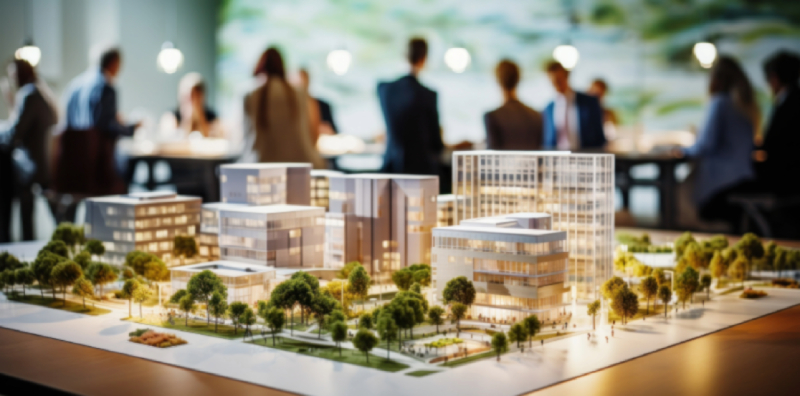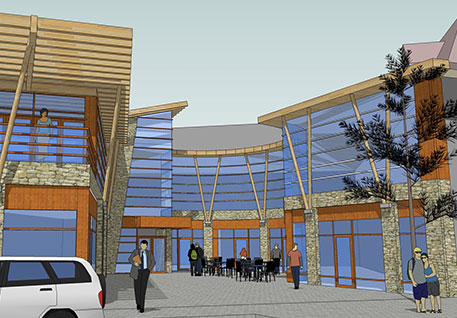Unveiling the Comprehensive Services Given by Commercial Architects for Modern Dope
Commercial Architects serve an important function in contemporary development tasks. They blend design aesthetics with performance while adhering to governing requirements. Their know-how prolongs beyond simple building, including lasting techniques and innovative modern technologies. As they browse intricate zoning regulations, Architects team up with different stakeholders to bring visions to life. This diverse technique questions about the evolving duty of Architects in forming modern-day rooms and the influence of their work with future growths.
Understanding the Duty of Commercial Architects in Modern Developments
In modern urban landscapes, Commercial Architects play an important function fit functional and aesthetic rooms that fulfill diverse company needs. Their proficiency expands past plain style; they browse complex zoning legislations, constructing codes, and environmental policies. By teaming up with clients, they recognize certain requirements, ensuring that each task aligns with the customer's vision while additionally considering useful facets such as sustainability and cost-effectiveness. Commercial Architects are adept at incorporating innovative innovations and materials into their designs, enhancing both the functionality and power effectiveness of structures. They carry out comprehensive site analyses to assess the prospective obstacles and possibilities presented by a place. Additionally, efficient interaction with specialists and various other stakeholders is vital, making sure that the project proceeds efficiently from perception to conclusion. Ultimately, Commercial Architects contribute in creating areas that not just accomplish sensible functions yet also add to the total personality and vibrancy of urban atmospheres.
Principle Style: Transforming Ideas Into Fact
Idea layout works as a vital phase in Commercial architecture, where ingenious design options arise from imaginative thinking. This process relies upon joint ideation, bringing with each other diverse viewpoints to fine-tune and boost first principles. As concepts take shape, they transform from abstract concepts into substantial building facts.
Ingenious Design Solutions
Changing ideas right into fact is the characteristic of innovative style services in Commercial architecture. These services mix imagination with capability, attending to the one-of-a-kind demands of modern-day growths. By leveraging sophisticated technologies and lasting techniques, Architects craft areas that are not only aesthetically attractive but additionally reliable and adaptable. Emphasis on individual experience drives the design process, ensuring that environments foster productivity and collaboration. Each task take advantage of a tailored approach, where principles are thoroughly established to mirror the customer's vision while thinking about future trends. Cutting-edge design services also focus on flexibility, enabling modifications gradually as service requirements develop. Eventually, these techniques improve the total worth of Commercial spaces, making them critical in today's affordable landscape.

Joint Ideation Refine
Partnership works as the foundation of the ideation process in Commercial design, promoting creative thinking and innovation among varied stakeholders. Architects, clients, engineers, and community participants take part in dynamic discussions, making certain that all viewpoints are considered. This comprehensive technique allows for the exploration of different style principles, encouraging distinct remedies that align with the job's vision. Through workshops and conceptualizing sessions, ideas advance and refine, transforming first principles right into tangible layouts. Innovation additionally plays a crucial duty, with devices such as Building Information Modeling (BIM) facilitating real-time collaboration and adjustments. Inevitably, this collaborative ideation process not just enhances the design result but also cultivates a sense of ownership and investment amongst all parties included, bring about effective Commercial developments.
Zoning Evaluation: Navigating Rules and Conformity
As programmers commence on brand-new jobs, comprehending zoning regulations is vital to making sure compliance and avoiding pricey delays. Zoning evaluation plays a crucial duty in this process, as it entails examining neighborhood zoning laws that dictate land usage, developing height, thickness, and obstacles. Commercial Architects possess the experience to navigate these complex policies, assisting customers recognize allowable uses and any kind of required variations.
Lasting Layout Practices: Structure for the Future
Lasting layout techniques are progressively essential in the domain name of Commercial style, particularly as environmental worries continue to rise. Architects focus on environmentally friendly materials, energy-efficient systems, and style strategies that minimize waste and ecological impact. Integrating renewable resource resources, such as photovoltaic panels and wind turbines, allows structures to generate their own power and lower reliance on fossil fuels.Furthermore, lasting layout stresses the relevance of indoor environmental top quality. This consists of utilizing all-natural light, boosting ventilation, and selecting non-toxic materials to boost occupant wellness and productivity. Environment-friendly roofs and living wall surfaces are likewise popular features that add to biodiversity and metropolitan cooling.Additionally, Commercial Architects commonly incorporate water conservation strategies, like rainwater harvesting and drought-resistant landscape design. With these innovative strategies, they create areas that not only fulfill contemporary requirements but likewise foster a lasting future, addressing the growing demand for liable advancement in the modern-day world.
Project Administration: Ensuring Timely and Efficient Implementation
Reliable project management is essential for making certain that Commercial design tasks are completed promptly and within budget my explanation plan. This function includes a variety of obligations, consisting of the sychronisation of various stakeholders, timelines, and sources. Commercial Architects leverage their expertise to develop detailed project plans that outline essential turning points and deliverables, enabling for systematic development tracking.Regular interaction among employee and customers is important, cultivating transparency and helping with timely decision-making. Risk monitoring techniques are additionally utilized to identify possible difficulties early, enabling positive solutions to be created. By making use of innovative project management devices, Architects can keep track of job performance in real-time, making changes as essential to preserve effectiveness.
Inside Layout: Creating Functional and Aesthetic Spaces
Interior style plays a crucial duty in improving both functionality and aesthetics within Commercial rooms. Efficient room preparation can Home Page enhance operations and improve individual experience, while visual style principles contribute to a visually attractive atmosphere - commercial architects. Together, these components create spaces that are not just sensible yet likewise motivating
Room Planning Efficiency
While maximizing the utility of available room, Commercial Architects focus on area planning performance to develop both useful and aesthetically pleasing atmospheres. This approach involves careful evaluation of the spatial layout to ensure suitable use every square foot. Architects consider factors such as process, ease of access, and all-natural light to boost usability. By tactically putting furnishings, devices, and workstations, they promote activity and interaction among users, promoting performance. In addition, zoning various locations for details features assists in managing sound and privacy, developing an unified environment. Through reliable space planning, Commercial Architects can change constraints right into chances, ensuring that each room satisfies the diverse requirements of its residents while adhering to regulatory requirements and sector requirements.
Aesthetic Layout Principles
Visual design principles play a vital duty in forming environments that are not only useful however additionally aesthetically attractive. These concepts direct Commercial Architects in creating rooms that resonate with users while boosting brand name identity. Secret elements include equilibrium, proportion, and harmony, which collaborate to create a cohesive appearance. Shade systems and materials are very carefully picked to evoke desired emotions and sustain the general motif. Furthermore, lighting plays a critical role, influencing state of mind and presence while highlighting building features. By integrating these concepts, Architects assure that areas are not only practical but likewise inviting and inspiring. Inevitably, effective aesthetic design fosters a positive user experience, urging involvement and contentment in Commercial settings.
Cooperation With Stakeholders: Promoting Successful Collaborations
Successful collaborations in Commercial style depend upon efficient partnership with check it out stakeholders, guaranteeing that every voice is heard and valued. This joint approach involves engaging various parties, consisting of customers, contractors, and community participants, throughout the layout and advancement process. By fostering open communication, Commercial Architects can attend to worries, collect insights, and straighten the job's vision with stakeholder expectations.The combination of varied viewpoints improves creativity and advancement, leading to even more practical and visually pleasing layouts. Routine meetings, responses sessions, and workshops promote this discussion, allowing Architects to adapt their strategies in action to stakeholder input. Furthermore, developing trust fund through transparency and responsibility enhances these collaborations, leading to a smoother job execution.Ultimately, the success of contemporary developments depends on the Architects' capability to navigate and harmonize differing passions, creating a joint setting that promotes shared goals and mutual success.
Regularly Asked Inquiries
Exactly How Do Commercial Architects Handle Budget Constraints During a Project?

What Kinds of Software Program Do Commercial Architects Typically Make Use Of?
Commercial Architects frequently make use of software application such as AutoCAD for drafting, Revit for Building Details Modeling, SketchUp for 3D modeling, and task monitoring devices like Microsoft Project to enhance cooperation and streamline operations throughout the style process.
Can Commercial Architects Aid With Acquiring Funding for Projects?
Commercial Architects can help in getting funding for tasks by preparing thorough propositions, helping to articulate layout visions, and providing economic forecasts that can enhance the likelihood of safeguarding required financing from financiers or banks.
How Do Architects Make Certain Safety And Security During the Building And Construction Process?
Architects assure security throughout building by applying strenuous layout criteria, collaborating with engineers, conducting regular site inspections, sticking to regional guidelines, and cultivating communication amongst all stakeholders to mitigate dangers and advertise a protected workplace.
What Ongoing Support Do Architects Give After Project Conclusion?
After project completion, Architects offer recurring support with maintenance assessments, performance evaluations, and style alterations. They ensure buildings satisfy progressing requirements, address possible issues, and preserve compliance with policies, cultivating a lasting relationship with clients.
Comments on “What Services Can You Expect From commercial architects After Project Handover?”